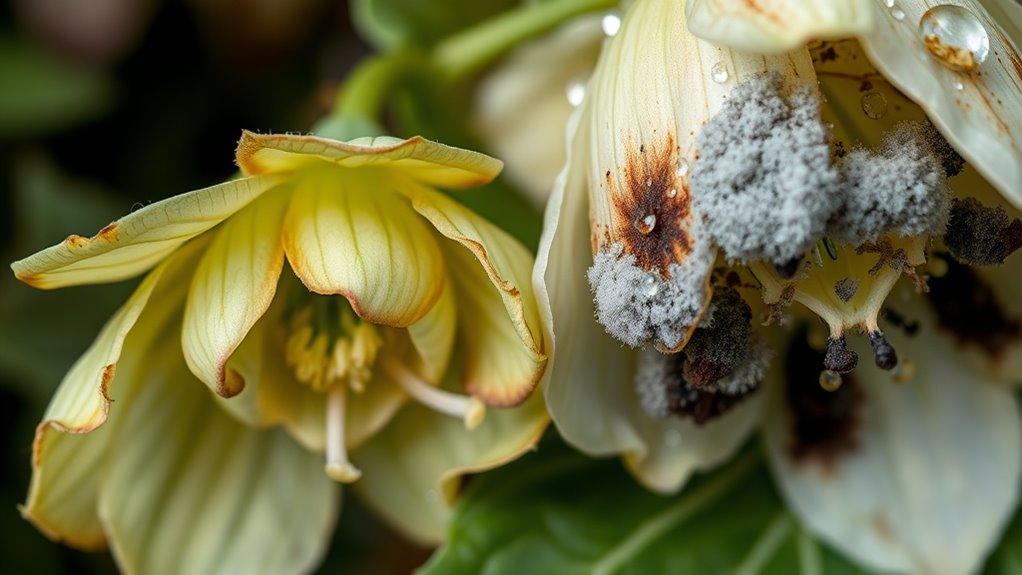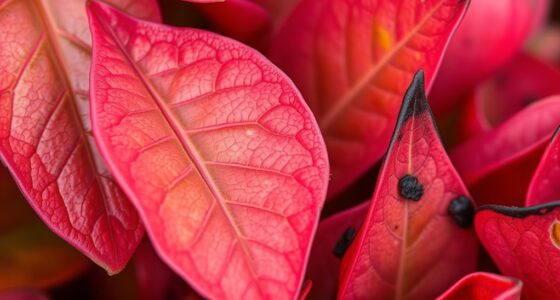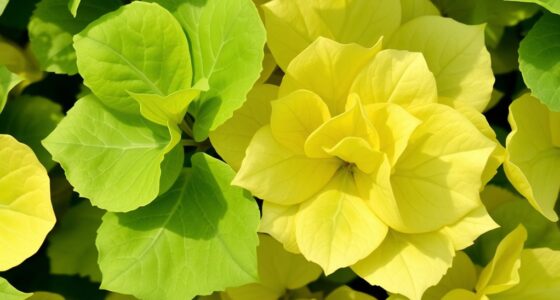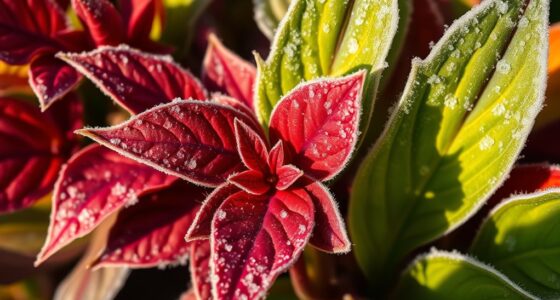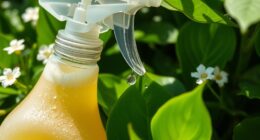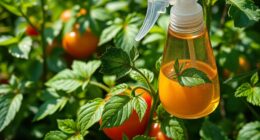If your hellebores droop, it could be due to heat wilt or botrytis blight. Heat wilt causes leaves to wilt and yellow during hot, dry weather, often recovering overnight with better moisture management. Meanwhile, botrytis blight produces fuzzy gray mold on flowers and leaves in damp, humid conditions. Spotting the difference between these issues helps you take the right steps. Continue exploring how to identify and treat each problem effectively.
Key Takeaways
- Heat wilt causes rapid leaf drooping during hot afternoons with quick recovery in cooler mornings, while botrytis blight shows gray mold and soft, water-soaked spots.
- Heat wilt is linked to dry soil and poor drainage, whereas botrytis thrives in damp, humid conditions with mold presence.
- Proper watering early in the day and shading help prevent heat wilt; good air circulation and removing infected tissue combat botrytis.
- Visual clues: yellowing, wilting leaves indicate heat stress; fuzzy gray mold and brown spots suggest botrytis infection.
- Monitoring environmental factors like temperature, humidity, and soil moisture helps distinguish between heat wilt and botrytis blight.
Recognizing the Symptoms of Heat Wilt

Heat wilt often shows up suddenly, leaving you puzzled about what’s wrong with your hellebores. You may notice the leaves drooping or wilting during hot afternoons, even if the plant looks healthy in cooler mornings. Poor soil drainage can worsen heat stress, so guarantee your soil drains well to prevent waterlogging, which can exacerbate the problem. Additionally, pay attention to fertilizer timing; applying fertilizer during peak heat can stress your plants further, making them more susceptible to heat wilt. Proper watering early in the day helps keep hellebores hydrated, reducing wilt symptoms. Recognizing these early signs and adjusting soil conditions and fertilizer schedules can help your hellebores withstand heat stress and recover quickly. Monitoring soil drainage and ensuring it is optimized can significantly reduce heat-related issues. Incorporating efficient heating and cooling practices, such as proper watering and shading, can further protect plants from extreme temperature fluctuations. Being aware of air circulation can also prevent heat buildup around your plants, promoting healthier growth.
Identifying Botrytis Blight in Your Hellebores

When you notice your hellebores developing unusual spots or fuzzy growths on their leaves and flowers, it might be a sign of botrytis blight. To identify it, look for these signs:
- Grayish, fuzzy mold forming on petals and foliage
- Wilting or browning of affected plant parts
- Soft, water-soaked spots turning into necrotic tissue
- Spreading mold during damp, cool weather
Regular monitoring helps with early detection and effective management of botrytis blight. Prevention involves soil improvement to enhance drainage and airflow, reducing humidity around plants. Regular pest control helps keep the environment less hospitable for the fungus. Prompt removal of affected plant parts limits spread. Monitoring your hellebores closely guarantees early detection and effective management of botrytis blight. Additionally, understanding plant disease mechanisms can aid in developing better prevention strategies, especially in humid conditions that favor fungal growth.
Environmental Factors Contributing to Heat Stress
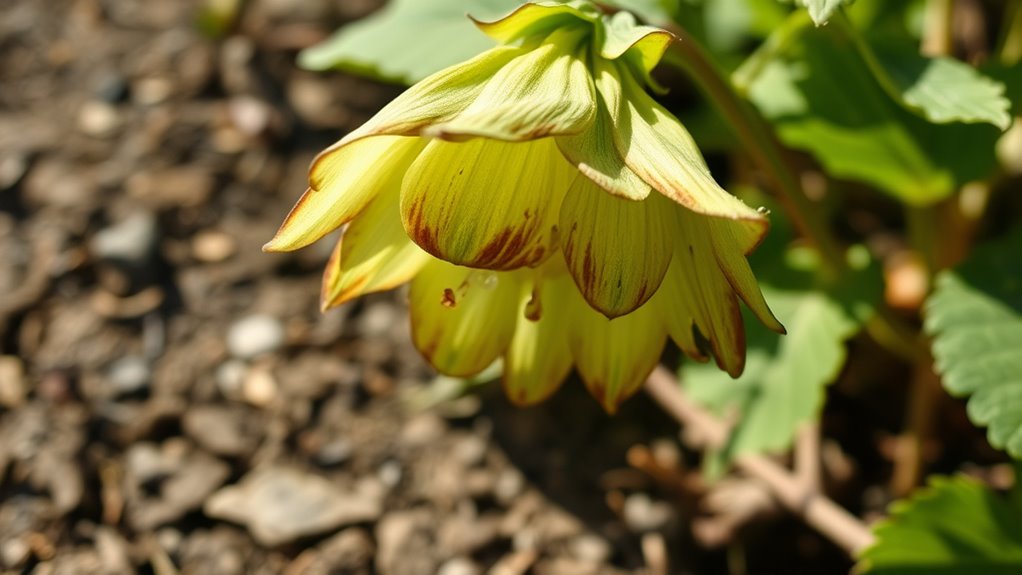
Excessive sun exposure can quickly lead to heat stress in your hellebores, causing drooping and damage. Persistent high temperatures make it harder for plants to stay healthy and vibrant. Poor air circulation traps heat around your plants, increasing the risk of stress and drooping. Implementing proper ventilation techniques can help mitigate heat buildup and protect your hellebores from stress. Additionally, understanding environmental factors like humidity levels can further improve plant health and reduce heat-related issues.
Excessive Sun Exposure
Have you noticed your hellebore drooping more during hot, sunny days? Excessive sun exposure can stress your plant, leading to wilting. To combat this, consider these steps: 1. Adjust your watering schedules—water deeply early in the morning to keep roots hydrated. 2. Use shading techniques like planting near taller plants or installing shade cloths during peak sunlight hours. 3. Incorporate proper fertilization techniques—use a balanced, slow-release fertilizer to strengthen your hellebore’s resilience. 4. Monitor sunlight patterns regularly and move containers to less intense spots if possible. Additionally, understanding plant stress factors can help you better protect your hellebore from heat-related issues. Recognizing self watering plant pots as a tool to maintain consistent moisture can further assist in preventing stress during hot weather. Being aware of climate-specific care strategies can also enhance your plant’s overall health during extreme conditions.
High Temperatures Persisting
Prolonged periods of high temperatures can intensify heat stress on your hellebore, especially if recent hot days caused it to droop more than usual. Persistent heat can dry out soil quickly, so soil drainage becomes critical for maintaining moisture. Using the right fertilizer types, like those with balanced nutrients, helps your plant withstand heat better. Poor soil drainage traps excess water, leading to root problems, while inadequate fertilization weakens overall health. To avoid further stress, ensure your hellebore is mulched and watered deeply during heatwaves. Here’s a quick guide:
| Aspect | Recommendation | Impact |
|---|---|---|
| Soil drainage | Improve with organic matter | Prevents waterlogging |
| Fertilizer types | Use balanced, slow-release fertilizers | Boosts heat resilience |
| Watering frequency | Water deeply in early morning | Maintains moisture levels |
| Shade options | Provide partial shade | Reduces heat stress |
Additionally, ensuring proper soil drainage can prevent issues related to poor water management that compromise plant health.
Poor Air Circulation
Poor air circulation can considerably worsen heat stress in your hellebore by trapping warm, stagnant air around the plant. This stagnation increases soil moisture levels, leading to root rot and making plants more vulnerable to heat damage. To improve airflow:
- Space plants properly to prevent crowding.
- Prune surrounding foliage to open up ventilation.
- Avoid overwatering, which can increase soil moisture and promote nutrient deficiency.
- Use mulch thoughtfully to regulate soil temperature without retaining excess moisture.
- Incorporate proper airflow management to monitor and adjust airflow regularly, ensuring optimal conditions for plant health.
Additionally, employing air circulation techniques can help prevent the buildup of humidity and heat around the hellebores.
Without good airflow, hellebores struggle to shed heat, exacerbating stress and slowing recovery. Poor circulation also limits the dispersal of humidity and heat, intensifying conditions that can lead to drooping or disease issues like botrytis blight. Ensuring proper airflow keeps plants healthy and resilient against heat stress.
Conditions Favoring Botrytis Development

Botrytis, commonly known as gray mold, thrives under conditions where humidity is high and air circulation is limited. Poor soil drainage creates damp, stagnant conditions around your hellebores, making it easier for the fungus to develop. Overly wet soil keeps foliage moist longer, encouraging mold growth. Additionally, fertilizer timing plays a role—applying too much or too late can promote lush, tender growth that’s more susceptible to infection. Avoid overfeeding, especially late in the season, to prevent soft, vulnerable tissue. Combining high humidity, poor drainage, and improper fertilization creates an ideal environment for botrytis to spread rapidly. To reduce risk, improve soil drainage, ensure proper watering, and apply fertilizer appropriately, especially during damp or cloudy periods.
How to Differentiate Between Heat Wilt and Blight
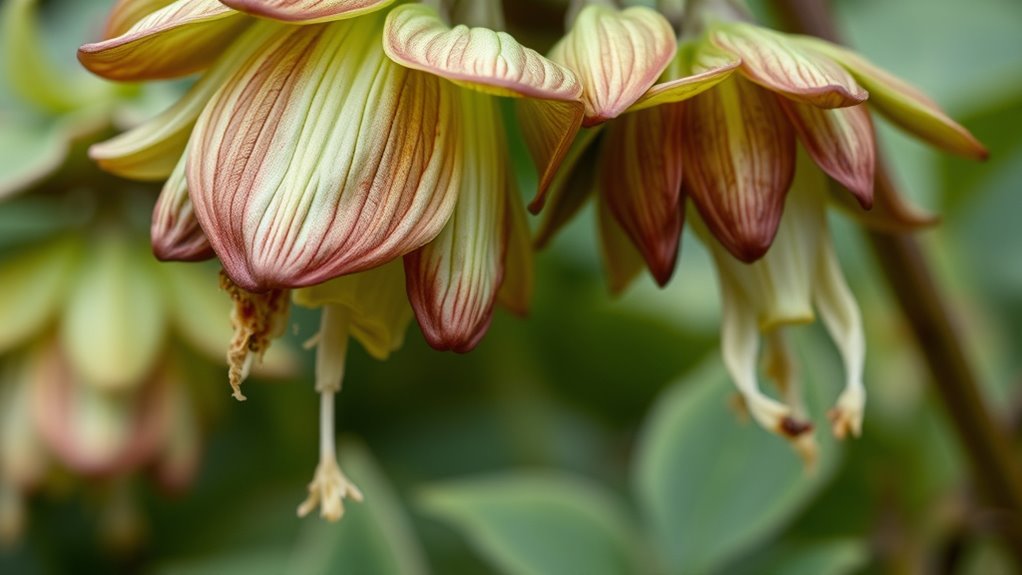
You can tell heat wilt from blight by examining the plant’s symptoms and the environment around it. Heat wilt typically causes leaves to yellow and wilt quickly during hot weather, while blight leads to spotting and decay on leaves and stems. Keep an eye on temperature and moisture levels to help identify which issue you’re dealing with. Additionally, inspecting for plant disease symptoms can help distinguish between the two conditions. Monitoring for environmental factors such as humidity and temperature fluctuations can also provide clues about the underlying cause of the drooping. Recognizing the cybersecurity vulnerabilities associated with plant health tools can further aid in safeguarding your data and diagnostics.
Visual Plant Symptoms
How can you tell if a drooping hellebore is suffering from heat wilt or blight? Look closely at the plant’s symptoms.
- Heat Wilt: Leaves droop during the heat of the day, then recover overnight. The soil drainage may be poor, causing roots to struggle, and over-fertilizing can worsen the effect. Ensuring proper soil conditions can help prevent heat-related stress.
- Botrytis Blight: You’ll notice fuzzy gray mold on flowers and leaves, often with brown spots. The drooping is more sudden and persistent, regardless of temperature.
- Soil Conditions: Heat wilt often relates to dry soil or poor drainage, while blight spreads in moist, humid conditions.
- Fertilizer Effects: Excess fertilizer can stress the plant, making it more susceptible to heat wilt, but it won’t cause blight.
- Environmental Factors: Proper understanding of topical plant health can help you recognize and address issues early, preventing serious damage.
These visual clues help you distinguish between the two issues.
Environmental Conditions
Environmental conditions play a key role in distinguishing heat wilt from blight in drooping hellebores. Heat wilt often occurs during hot, dry weather when soil moisture drops, causing plants to wilt and droop quickly. You’ll notice the affected plants recover overnight if moisture levels improve, but persistent dryness worsens the problem. In contrast, botrytis blight thrives in cool, damp conditions, with high humidity promoting fungal growth. Here, drooping leaves might be accompanied by fuzzy gray mold, especially during rainy or humid periods. Fertilizer impact also matters: excessive or imbalanced fertilization can weaken hellebores, making them more vulnerable to heat stress. Monitoring soil moisture and environmental humidity helps you determine whether heat wilt or blight causes drooping, guiding proper treatment.
Preventive Measures for Heat-Related Stress
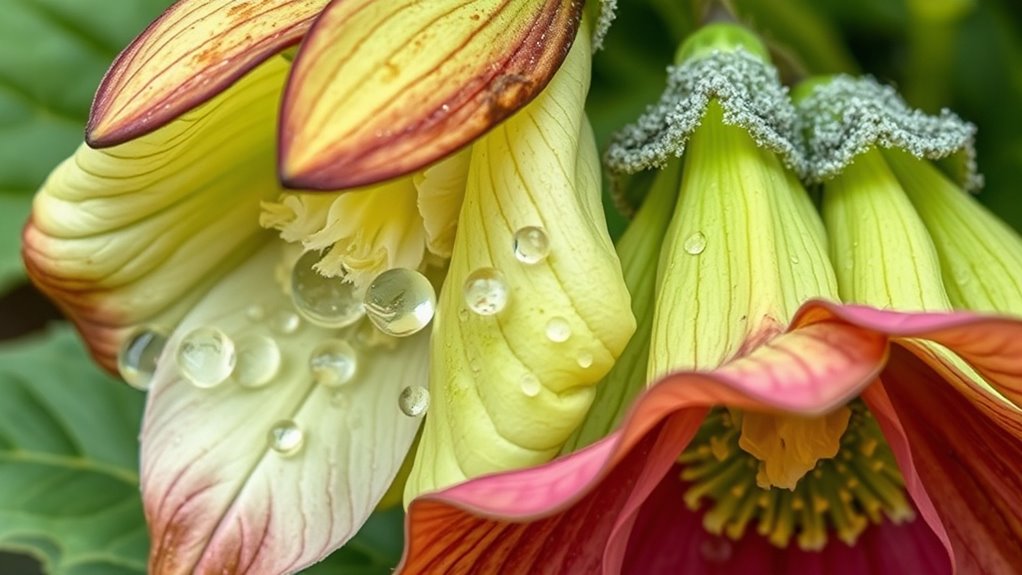
To minimize heat-related stress in hellebores, implementing proactive measures is essential, especially during hot weather. First, ensure consistent soil moisture by watering deeply and regularly to prevent dehydration. Second, apply a balanced fertilizer to support plant health and boost resilience against heat. Third, add mulch around the base to conserve moisture and regulate soil temperature. Fourth, consider providing partial shade during the hottest parts of the day to reduce heat buildup. These steps help maintain ideal soil conditions and strengthen hellebores against heat stress. Staying vigilant about soil moisture levels and proper fertilizer use will keep your plants healthy and vibrant, even during high temperatures. Proper prevention can greatly reduce drooping caused by heat wilt.
Managing Botrytis Blight Effectively

Managing botrytis blight effectively requires prompt action and proper cultural practices. Start by practicing disease prevention through good air circulation around your hellebores, which helps reduce humidity that fosters fungal growth. Remove any infected plant material immediately to prevent the spread. Maintaining soil health is vital; ensure well-draining soil and avoid overwatering, as excess moisture encourages botrytis development. Mulching can help regulate soil moisture and temperature, reducing stress on your plants. Regularly inspect your hellebores for signs of infection, and apply appropriate fungicides if necessary. By combining these steps, you strengthen your plants’ resilience and minimize botrytis blight’s impact. Consistent care and attention are key to keeping your hellebores healthy and disease-free.
Cultural Practices to Keep Your Hellebores Healthy
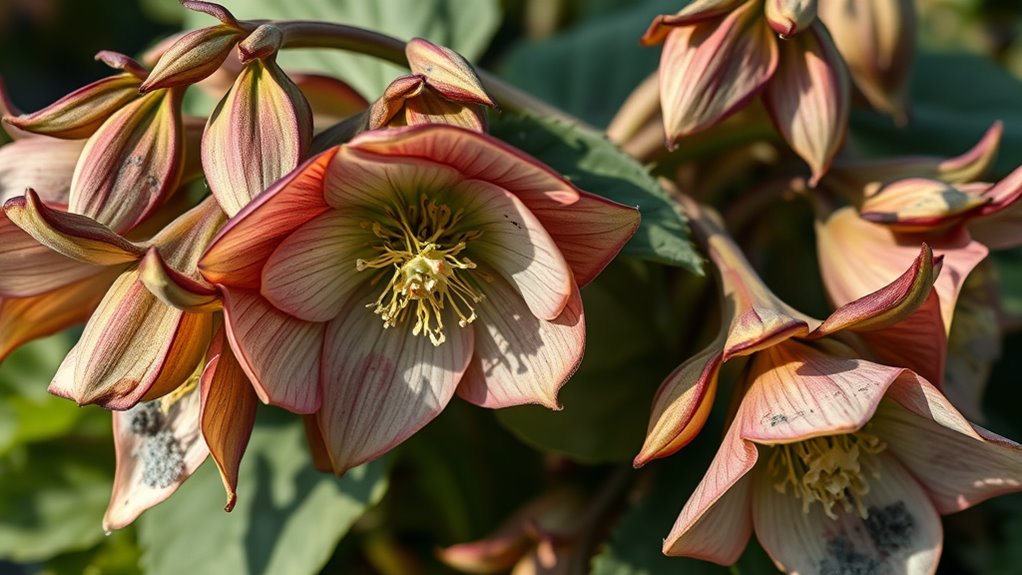
Implementing proper cultural practices is key to maintaining healthy hellebores and preventing issues like botrytis blight. First, improve soil drainage by adding soil amendments such as compost or organic matter, which help prevent excess moisture that fosters fungal growth. Second, practice regular pruning techniques by removing dead or diseased leaves and stems to improve air circulation. Third, avoid overcrowding plants, giving hellebores enough space to breathe and dry out after rain or watering. Fourth, mulch around the base with organic material to regulate soil moisture and temperature. These steps promote a healthy environment, reduce disease risk, and keep your hellebores vigorous and resilient throughout the growing season.
When to Seek Professional Assistance
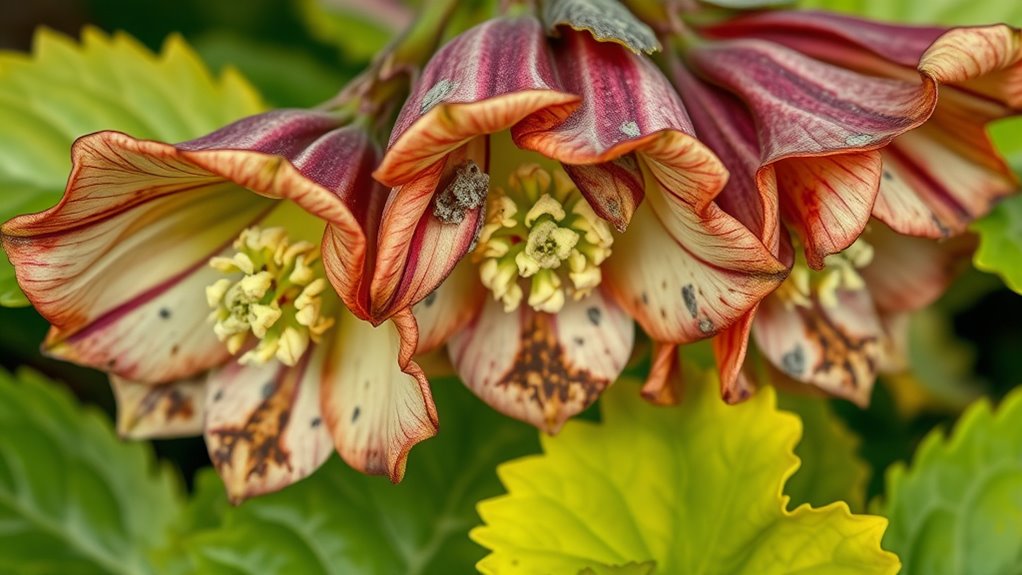
Sometimes, despite your best efforts, hellebores continue to droop or show signs of distress that you can’t easily resolve on your own. If you notice persistent wilting, browning, or mold, it’s time to seek professional assistance. A plant expert can assess fungal resistance and determine if botrytis blight or heat wilt is causing the problem. They can also evaluate soil moisture levels, which are vital in managing fungal diseases and preventing overwatering. If adjusting watering practices or cultural methods doesn’t improve the plant’s health, consulting a professional guarantees you get targeted treatments. Recognizing when to ask for help can save your hellebores from further damage and guarantee they thrive in the long run.
Frequently Asked Questions
Can Heat Wilt and Botrytis Occur Simultaneously on Hellebores?
Yes, heat wilt and botrytis can occur simultaneously on hellebores, leading to disease overlap. You need to carefully observe symptoms to differentiate them, as heat wilt causes wilting due to heat stress, whereas botrytis results in gray mold and tissue decay. By monitoring your plants closely, you can identify overlapping symptoms and manage each issue appropriately, preventing further damage and ensuring healthier hellebores.
Are There Specific Hellebore Varieties More Resistant to Heat or Botrytis?
Oh, the irony of finding the perfect hellebore that’s resistant to everything! While some varieties boast higher resistance to heat or botrytis, no plant is completely immune—it’s all about managing disease susceptibility. For example, certain cultivars excel in resisting heat wilt, but might be more prone to botrytis. Your best bet is choosing varieties with proven resistance and practicing good garden hygiene to keep your hellebores thriving.
How Long Does It Typically Take for Symptoms to Appear After Stress Exposure?
When your hellebore experiences stress, symptoms usually appear within a few days to two weeks, depending on the specific stressor. The timing of symptoms varies based on factors like temperature, humidity, and plant health. A quick stress response might show drooping or discoloration within days, while more gradual effects, such as leaf spots or mold, develop over weeks. Recognizing these signs early helps you address issues promptly.
What Are Natural Remedies to Treat Hellebore Drooping Caused by Heat or Blight?
Think of treating hellebore drooping like soothing a child—gentle and natural. You can try companion planting to improve plant health and airflow, reducing stress. Organic fungicides, like neem oil or copper sprays, help combat blight without chemicals. Confirm proper watering and remove affected leaves to prevent spread. These natural remedies boost resilience, allowing your hellebores to stand tall again without harsh treatments.
Is It Safe to Prune Hellebores During Hot or Humid Weather?
You might wonder if it’s safe to prune hellebores during hot or humid weather. It’s best to avoid pruning during these times because the pruning timing can stress the plant and make it more vulnerable. For disease prevention, prune early in the morning or late in the afternoon, when conditions are cooler and humidity is lower. This helps reduce the risk of infections like botrytis blight and keeps your hellebores healthy.
Conclusion
To keep your hellebores thriving, stay vigilant like a seasoned gardener in a Victorian greenhouse. Recognize the signs of heat wilt and botrytis blight early, and act swiftly with proper cultural practices. Remember, prevention is your best armor—think of it as your garden’s suit of armor, shielding against nature’s whims. With attentive care, your hellebores will flourish, blooming beautifully as if time itself paused just for them.
